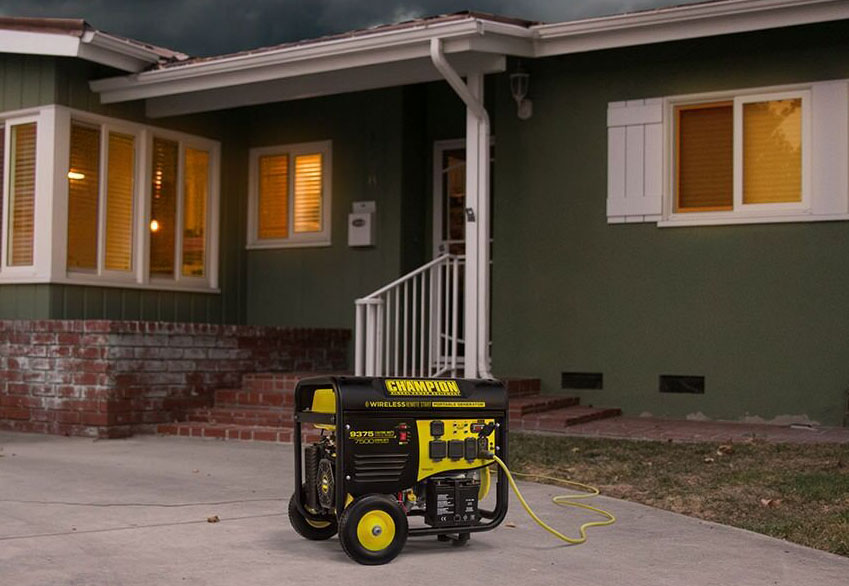
In an outage, you’ll probably have enough trouble to contend with, without adding a fire or health emergency caused by your generator. A few safe-practices can help you avoid trouble.
These are tips for using portable generators. If you have a stationary, whole-house generator installed, many of the dangers will have already been addressed. The installer will have located the unit in a proper place outdoors. They will have installed a transfer switch or interlock. This post is for the rest of us with smaller, portable units.
Carbon-monoxide Awareness
One of the most common dangers with portable generators is carbon monoxide poisoning. Something like a hundred people die each year from carbon monoxide poisoning. Your generator’s exhaust gas is mostly carbon dioxide and water vapor. However, some carbon-monoxide is also produced. Less-complete combustion (think poorly tuned engine), creates still more CO. Even a well-maintained engine will produce some CO.

Rather than stress over it, just accept the fact and make sure you run your generator outdoors — not in a garage or some other room connected to your house.
Even with a door or window open to the outdoors, CO will not vent away as much as you’d like to think. CO is not like a trapped sparrow eagerly seeking freedom. It diffuses evenly and just hangs there. Some of it will diffuse out of an open window, yes, but the rest of it is looking for other places to diffuse to (like your bedroom).
CO is not heavier than air (contrary to popular myth). It is actually similar in density to air. Air: 1.22 kg/m3. CO: 1.14 kg/m3. Those numbers show you that, if anything, CO is just slightly lighter than air. It is not light enough (like methane or helium) to persistently float up through a roomful of air and collect around a ceiling. CO neither rises or sinks, it just spreads out. Since it diffuses easily, it finds its way through any available openings — cracks up high or down low — all gaps are fair game.
Never run your generator indoors. Even a garage with the door open is not open enough. Many people make this mistake every year.
Location, Location, Location
If you can’t run your generator in the protected space of your garage, then where? Ideally, it will be far enough from your house (especially away from doors and windows) to permit good airflow. The CDC recommends 20’ away but I’ve noticed that stationary whole-house generators are seldom placed that far away. Before there is an outage, figure out a good place where your generator should be set up.

The Chimney Effect — When you are trying to figure out a good place to station your generator, keep in mind the chimney effect. Warm air rises and pulls cooler air in behind it. During cold weather, when you are heating your house, your heated air finds little cracks to leak up into your attic (or outside). Cold air is pulled in from down low to replace it. Notice, in the photo at right, that this homeowner has his generator outside, but very near the garage doors. It looks like the living quarters are above the garage. Assuming he’s heating the upstairs, warm air is leaking up and out. Cool air is being pulled in. Even though the garage doors are closed, they are not air-tight. The chimney effect is slowly pulling exhaust fumes into his house.
While the CDC’s advice is prudent, a lot of people do not want their generator located 20 feet from their home. There is the real potential for theft by the unprepared and unscrupulous. There is also increased exposure to bad weather. You will get wet checking on it and your generator will also be getting wet.
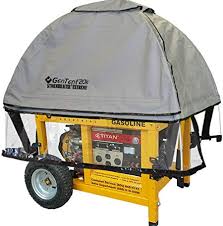
Be Dry — Another factor in locating a spot for your generator is protecting it from the weather. Electrical things don’t like getting rained on. Wherever you decide is a good spot, figure out some way to give your machine some cover. Some people construct little sheds for their generators, which include venting, of course. Little sheds are nice if you’re DIY-handy. Once you’ve figured out the “good spot,” it could be enhanced. But, if you don’t want to commit to a little shed in your yard, there are little generator tents you can buy. Who knew?
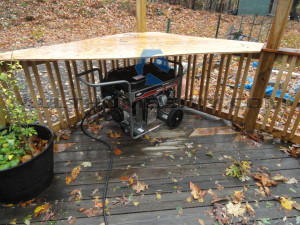
I use something temporary but sturdy. My generator spot is the far corner of my deck. It’s eight feet away from the house, under no eaves, and exposed to whatever breeze there might be. The exhaust pipe is aimed away from the house. Sitting in the corner of the deck, I can make a temporary little roof over the generator with a partial sheet of plywood. That keeps the rain off of it, yet permits airflow. It is also easy enough for me to access the machine to start, stop, and refuel. It is also far from the road so not quickly snatch-able.
Fill The Gaps
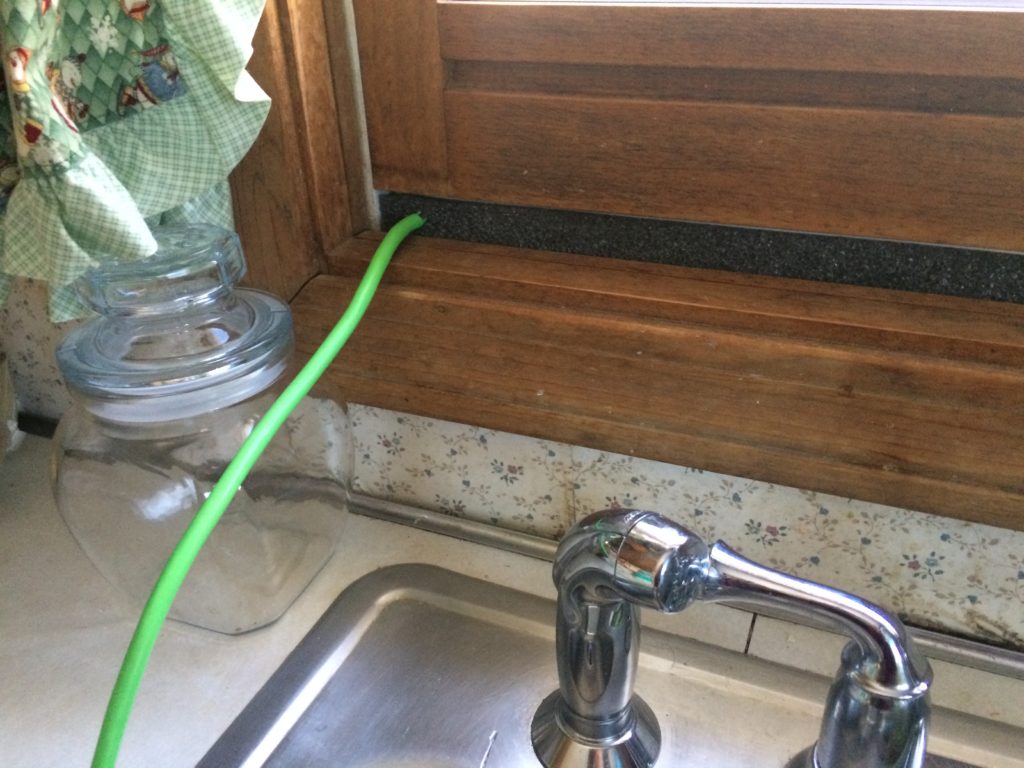
How will your extension cord enter your house? Through a window? A door? Plan ahead for something to fill the gap. You don’t want to give CO an easy way in. A closed-cell foam (like is used in things like pool noodles and shipping spacers) can be handy. It cuts pretty easily with a knife, has enough squish to get a useful seal, and is not porous.
Locate your generator deployment spot. Identify where the cord will come in and cut your gap sealer to fit. Stash that with your extension cord or the generator. The dark of night is a poor time to be looking for a pool noodle.
Detector in Reserve

Another good tool for generator use is a battery-powered carbon monoxide detector. You might have a plug-in version (I do) but it won’t work when the power is out. We bought this one (pictured) but keep the batteries out of it until we need it. We save it for outages. The gas detector cells wear out after five or six years of use. The ‘test’ button does not tell you how well the detector’s cell is working. They usually only tell you how the battery is. The First Alert unit we got has a four-beep alert to let you know if the detector cell is near the end of its career. That’s something I want to know.
Where to put your detector? The old wisdom was to place it down low, on the mistaken belief that CO is heavier than air. Now that we know that’s not the case, it is actually more useful to have the CO detector mounted up near the level of your nose. That’s the air you will be breathing, after all.
Proper Pluggage
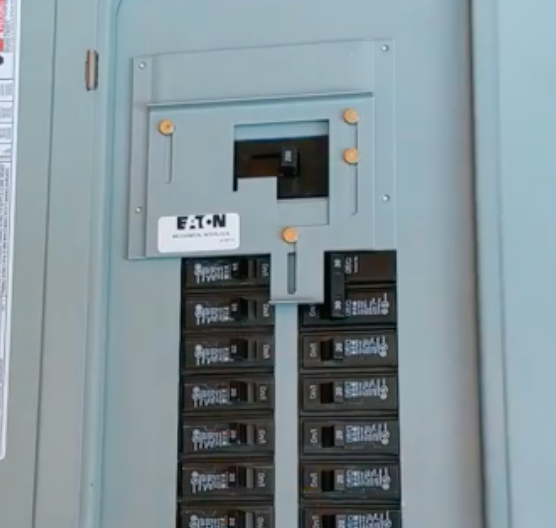
If you can afford to have a transfer switch or an interlock installed, that is the safer way to go. Doing so tends to come along with the assumption that you will be generating enough to drive your home’s wiring. It’s dicey having a 3000-watt generator for a house demanding 4500 watts. You can make it work, but you’ll have to act as your home’s Energy Police, turning off breakers to big-amp circuits to ensure family members are not expecting more wattage than your generator can provide.
For smaller generators that don’t merit the expense of a transfer switch, plan on running extension cords from the generator directly to your appliances. After you’ve located where your generator will be, and how the cord will enter your house, you can sort out how long of cords (and how many) you will need to reach your appliances. Better to figure these details out ahead of time, while you can get to the store and buy more cords if you need to. Once the grid goes down, you will probably not be able to buy any.
When you do buy extension cords, err on the side of heavier duty. They will be a little more expensive but heavier gauge wire (such as 14 or 12 gauge) will conduct your load without heating up. Too thin of cord, trying to carry too much wattage, will heat up, becoming a fire hazard. As a rough guide, a 50’ cord of 16 gauge wire can handle 1500 watts. A 14 gauge cord can handle 1800 watts. A 12 gauge cord can handle 2400 watts.
Just Say No To These Guys

You can actually still buy male-to-male plugs such as the one shown here. Some people make their own. They are tempting as a shortcut to a proper transfer switch. Plug one end into your generator and the other end into a socket to your home’s wiring system and BOOM, you’re putting power into your home’s wiring. Easy-peasy, right? There are too many big risks to this shortcut.
The biggest safety risk is that full voltage is available at the male prongs when your generator is running. It is far too easy to touch hot prongs. Yes, if you plugged in both ends first and then fired up the generator it would be safer — but why risk it? Cords come unplugged.
Another safety risk is that you will also be feeding voltage back into the power grid if you forgot to throw your main breaker off. Some lineman may be trying to work on the power lines, assuming the power is off. If you’re feeding the line, it won’t be off. You could kill him.
Yet another hazard is fire. Odds are, the socket you’d plug the male-to-male into will have lighter gauge wiring, rated only to power that socket — after the circuit breakers — not the whole house. Putting large amounts of power through thinner wires on the wrong side of the breakers risks a fire inside your walls. And, at a time when the fire department won’t be coming. Just say no to double-headed cords.
Fuel Before or After, Feel Better
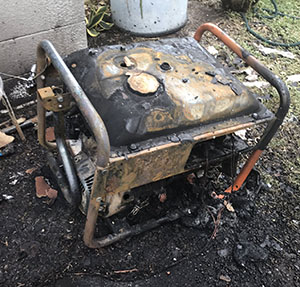
Many generators caution users not to try and refill their fuel tanks while the generator is running. (Does anybody read instructions anymore?) You would think it was obvious to NOT pour gasoline over a hot muffler or a machine making sparks — and yet, people still do it. Maybe they think they’ll be careful. It’s starting to rain and getting dark. They don’t want to go out later in the full storm, so they try to top up the tank while the gen-set is running… What could go wrong? Don’t be that guy.
Monitor your fuel use so you don’t run out in mid-cycle. Here, I’m assuming that you will be using the Third World Method mentioned in my previous post. Run an hour or so, rest for four or five, etc. The “off” periods give the unit time to have cooled off. Then refill the tank. Otherwise, plan ahead for a good time to power down for a half-hour or so.
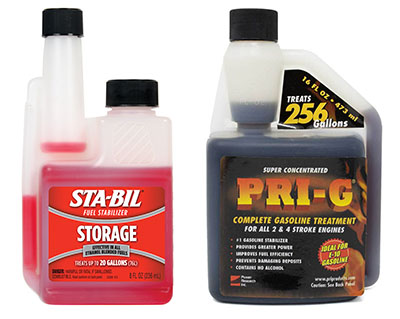
Storing gasoline for your generator requires a little care of its own. Gas containers should be sealed tight to prevent air from getting in. This weakens the gasoline, Small engines can struggle with the reduced power of weak gasoline. Gas containers should be kept out of the sun and heat, too. Products like Sta-bil or PRI-G added to the gasoline will extend its quality life. Even treated gasoline will not stay good forever, though. Rotate your stock. Don’t count on ten-year-old gas for your backup fuel.
Properly cared for, a container of gas can remain good for your generator for a year, maybe two. Write dated labels on your cans when you fill them. When they get to be a year old, pour the fuel in your car’s tank (bigger engines are less fussy) and refill the gas can. By rotating your stored fuel, you can be more confident that it won’t let you down at the very moment you need it.
Practice!
Some people buy a generator “just in case” and leave it in the box until they need it. That is a false sense of security. Facing the confusion during an outage will be an awful time to find out they don’t know how to operate it. For instance, many generators are shipped without any oil in them (better for shipping), so they cannot be run right out of the box. They need prep.

Instead, oil it up, gas it up, start it up. Get familiar with its controls and idiosyncrasies. My little generator, for example, wants the throttle set to choke to start for just a few seconds. After that, the throttle must be moved off of the choke position to “just the right spot.” That has proven to be a fussy throttle position. Too far back and the unit’s auto-throttle will let the engine stall under full load. Too close to choke, and it runs too rich which fouls the plug after only a half-hour of runtime. Having learned this, my generator and I get along fine. Your unit may have some foibles too. Learn them now, when you don’t need the power.
Practicing how to set up your generator in its protected safe spot is a good way to identify logistical problems before it is a dark and stormy night.
Conclusion
A backup generator is great to have but it is a flower with a few thorns. Figure out how to deal with the thorns now while the lights are on and the stores are open. That way, you can get your Plan B ducks in a row for the time you’ll really need them.
Up next will be a Plan B to your Plan B.

Please don’t use a male to male plug to wire your house into the portable generator. A typical 20 amp circuit can carry 2400 watts safely but most portable generators can throw out more than that causing a real fire hazard. Generators don’t throttle back when called upon for power so it’s easy to have a in wall house fire this way.
Also as Mic noted too easy to back feed into what the lineman “knew” was dead and injuring or killing him when he’s trying to help you. Even shutting off the main breaker ASSUMES that no backyard engineering was done over the years that violates that safety idea. I’ve been shocked literally many times working on a “Dead Circuit.
Pay an electrician to wire it up or do with extension cords PLEASE.
Run your generator on natural gas and/or propane. Conversion kits available to convert a gasoline generator to be able to run on all three types of fuels. Best is natural gas and then propane. Propane will last for years. Perhaps not a safety feature but generators use a lot of oil when running and will shut down when they get low. There may or may not be an indicator that the reason the generator stops is due to a lack of oil. If there is a way to connect an oil gauge to a generator then I’d like to know. Develop a checklist on what to do to when the power goes out. Make sure it is accurate before it is needed and follow it strictly when it is needed.
Hi Tom,
Good point about the fuel conversions. Worth looking into as you’re right about the better storage life of propane. Natural gas isn’t always available, but the 20 lb. tanks are pretty universal. Also a good point about the oil. My generator actually holds less than a pint of oil when full. It does not take much runtime to wear that down to the cutoff you mentioned. I keep handy a spare bottle of just the right amount of oil for a fill so I’m not trying to guess the amount on a dark and stormy night. Checking your oil level each autumn is a good idea too.